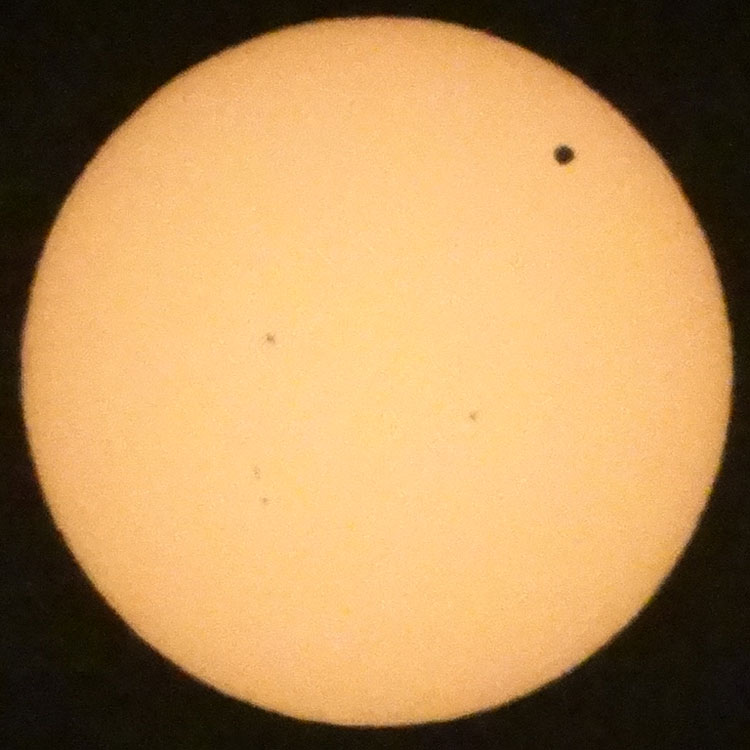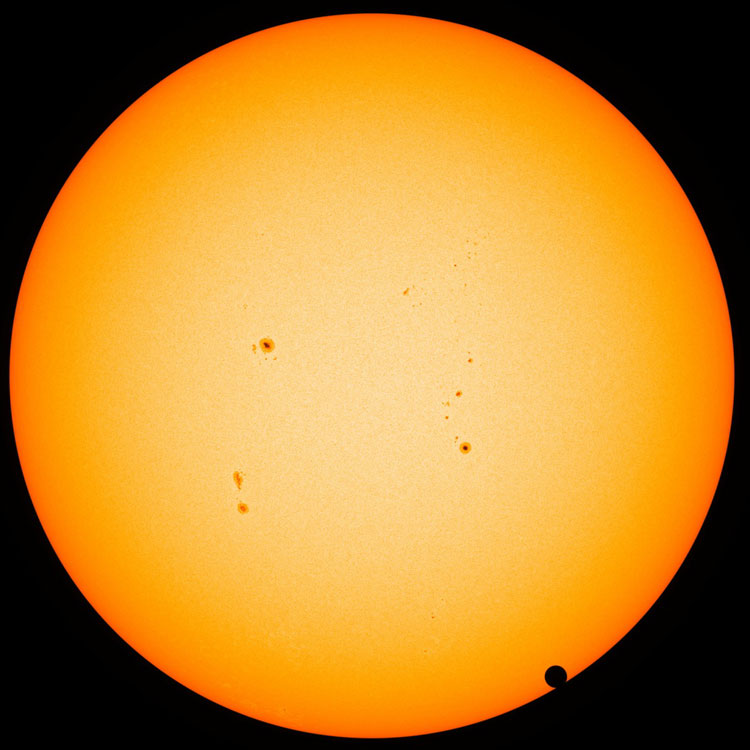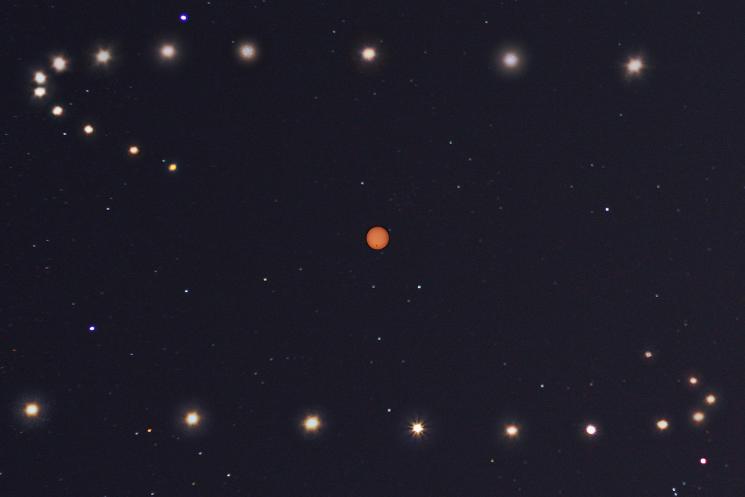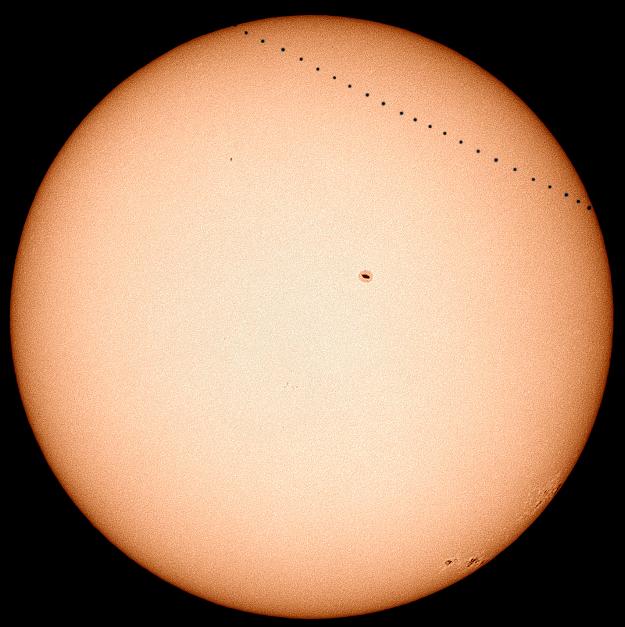Images of the June 5, 2012 Transit of Venus
The Sun has gone to bed at my place, and so I will I in a few minutes; but I wanted to note that I took a number of pictures of the transit using a Sony CyberShot camera mounted on a tripod, with a 30 power zoom lens (protected by taping one half of a pair of eclipse glasses over the front of the lens). The images are not as sharp as those taken with telescopes, but provide a good idea of what the transit would have looked like to observers using (safely eye-protected) binoculars, or "pinhole camera" type projection of the Sun and Venus. There are even several sunspots faintly (and fuzzily) visible on the images, which is more than I hoped for when I decided to try this setup. I'll post more of the images later, but save for the position of Venus they mostly look the same.

Above, an image taken about halfway through Venus' entry onto the solar disk (about 3:12 pm PDT)
Below, an image taken 16 minutes later shows Venus fully in front of the Sun

Below, half an hour into the transit Venus is well away from the limb of the Sun

Below, an hour into the transit Venus is still further from the limb

(More pictures to follow, but not the whole transit, as the Sun went down in California before it ended)
Below, a space-based image taken near the end of the transit (Credit NASA/SDO + AIA, EVE, & HMI teams)
(Nice to have no atmosphere blurring the view and a special telescope to take the image)

June 5/6 Transit of Venus
The 2012 transit of Venus, which was literally a once in a lifetime event for anyone who didn't get to see the transit in 2004, occurred on June 5th (for observers east of the International Date Line) or 6th (for observers west of the International Date Line). For observers in the continental United States the transit began around 6 pm EDT (3 pm PDT) and ended after sunset. The official time of the start of the transit was about 6:07 pm EDT, but observers in the continental United States were on the eastern side of the Earth as seen from Venus and the Sun, which means they saw Venus a little to the west of its "normal" position. Since Venus moves from east to west as it passes in front of the Sun, the slightly more westerly appearance of the planet allowed eastern observers to see the start of the transit a few minutes earlier than those who lived to the west of them (this few minutes difference was the reason for the transit expeditions of the 18th and 19th centuries). For observers in the western United States and the eastern Pacific, the transit started closer to its "official" time. For all continental U.S. observers, the 'live' transit (as observed using special eye protection, as discussed in 'Looking at the Sun' below) started before it did in Hawaii, the location of the NASA webcast. However, continental observers saw only part of the transit, as the further east they were the earlier the Sun set relative to the six hour duration of the transit.
There is a discussion of transits in general, images of the 2004 transit of Venus, a discussion of why transits are relatively rare (there will be only a little over a dozen transits by Mercury during the rest of this century, and the next transit of Venus is more than a century away), and why they occur only at certain times of the year further down on this page.
Looking at the Sun — A Warning and A Suggestion
This page discusses events that occur when a planet passes in front of the Sun. After reading it you should feel some enthusiasm about looking at the Sun when one of those events occurs. However, a warning is in order:
All solar images on this site were taken with filters that blocked at least 99.999% of the light of the Sun (all of its light, including not only visible light, but also infrared and ultraviolet radiation). Looking at the Sun during an eclipse or transit is no more dangerous than looking at it at any other time, but it is ALWAYS dangerous to stare at the Sun without filters that block almost all of the Sun's radiation. Looking at the Sun with sunglasses or other filters not specifically made for looking at the Sun can result in partial or total blindness. (For examples of truly safe solar filters, use this link.) Even with such filters some doctors recommend only observing the Sun for a few minutes at most, then giving your eyes a rest; if you see an afterimage of the Sun when you rest your eyes, you should observe it for shorter periods. One way of safely looking at the Sun is to use a "pinhole camera", which can be as simple as an opaque piece of paper or cardboard with a very small hole in the middle. Holding the paper a few feet from the ground so that it casts a shadow of itself normally shows a small round ball which is an image of the round disc of the Sun. During a partial eclipse of the Sun the round ball will have a chunk taken out of one side, which is the circular outline of that part of the Moon which is covering the Sun. Most people don't realize it, but the dappled light under trees is often a multitude of pinhole images of the Sun. During Solar Eclipses those images become crescents representing inverted images of the Sun. During a planetary transit of the Sun a very tiny black dot might be seen in front of the Sun, gradually passing from its eastern side to its western side, but the dot would be so small it might not be discernable, so direct viewing with a solar filter is more satisfactory.
Review of Retrograde Motion
As the Earth and other planets move around the Sun, they sometimes lap each other. At such times, the inner planet sees the outer planet opposite the Sun, at opposition, and the outer planet sees the inner planet more or less in line with the Sun, at conjunction. There are actually two times when an outer planet sees an inner planet more or less in line with the Sun, so to distinguish the two, the one where the inner planet passes in between the Sun and the outer planet and they are at their closest to each other is called inferior conjunction, while the one where the inner planet passes on the other side of the Sun, so that the planets are at their furthest from each other, is called superior conjunction.
At the time that the two planets are at their closest, they are both going in the same direction, but the inner planet is going faster, so the outer planet appears, from the inner planet, to be going backwards, or in retrograde motion. (The outer planet also sees the inner planet in retrograde motion as well, but that requires a little extra discussion, which will be covered at another time.)
The most easily observed retrograde motions are when the inner planet sees the outer planet when it is opposite the Sun, and up all night. The retrograde motions that occur when the outer planet looks at the inner planet are harder to see, because the inner planet is close to the Sun and only appears in the sky shortly after sunset or shortly before dawn. Still, particularly for Venus, because of its brilliance, it is relatively easy to observe its retrograde motion, as shown in the image below.

The retrograde motion of Venus in 2004. The position of the Sun is shown on the date when Venus was at inferior conjunction — an unusual conjunction that included a transit of Venus. (Tunc Tezel, apod050107)
Transits of Venus and Mercury
The image above displays a rare conjunction, one in which Venus passed directly between the Earth and Sun, producing a rare transit of Venus across the face of the Sun. In astronomy, transit has two meanings — an everyday one, referring to the moment when a celestial body crosses the Meridian and is at the highest point of its diurnal path; and a more specific one referring to the rare occasions when Mercury or Venus, passing through inferior conjunction, also passes directly in front of the Sun, and is seen silhouetted against it.
Each time that an inferior planet passes through conjunction, which is every 116 days for Mercury and every 584 days for Venus, there is a possibility that it will pass in front of the Sun, but because the orbits of the planets are tilted relative to ours, transits only occur happens when the planet is also near a node of its orbit (one of the places where its orbital plane crosses the orbital plane of the Earth), which happens every 44 days for Mercury, and every 112 days for Venus; otherwise, the planet will pass above or below the Sun instead of in front of it. As a result transits are relatively rare, occurring only around a dozen times per century for Mercury, and for Venus less than twice per century. In fact, transits of Venus usually occur in pairs 8 years apart, separated by alternating periods of 105 1/2 years and 121 1/2 years, with the latest transits occurring in June of 1761 and 1769, December of 1874 and 1882, and June of 2004 and 2012; and the following transits occurring in December of 2117 and 2125. Note that there were no transits of Venus in the 1900's, and not one person who was alive at the time of the 1882 transit was still alive when the next one occurred in 2004, making it a truly rare event.
Since the image above, showing the 2004 retrograde motion of Venus, includes the inferior conjunction for the 2004 transit, if you look very carefully, you can see Venus in front of the Sun; but in case you can't, the image immediately below shows that portion of the image considerably enlarged; and below that is a spectacular image of the transit, one of many posted on various websites during the weeks following the 2004 transit. Note that in the images below, Venus and Mercury look larger in comparison to the Sun than they really are, because when passing between us and the Sun they are closer to us than the Sun is.

The central portion of the previous image, enlarged to show the transit of Venus.
(Tunc Tezel, apod050107)

The 2004 transit, using filters which show details in the solar chromosphere.
(Stefan Seip, apod040611)
Similarly, the image below shows a more common but still not everyday transit of Mercury which occurred in May of 2003. Unlike the images of Venus' transit, which showed the position of Venus at only one moment, the image below is a superposition of 23 images taken about 15 minutes apart, over a period of more than 5 hours (in an animation, Mercury would be moving down and to the right as time passed, because it was in the middle of its retrograde motion, and therefore appeared to be moving westward relative to the Sun and stars). Recent transits of Mercury occurred in November of 1973, 1986, 1993, 1999 and 2006, and in May of 2003. The next ones occur in May of 2016, November of 2019, 2032, and 2039, and May of 2049.
 The 2003 transit of Mercury. The series of dots crossing the solar disk (in a line at upper right) show the location of Mercury at different moments during the transit. The dark area near the middle of the Sun, and the dark and light areas on the lower right, are a sunspot and sunspots surrounded by faculae. (Dominique Dierick, apod030527)
The Timing of Transits
Observant individuals might have noticed that all the transits of Venus occur in June and December, which are six months apart, and all the transits of Mercury occur in May and November, which are also six months apart. The reason for this is that transits can only occur when (1) a planet is near a node of its orbit, so that it is near the plane of our orbit instead of above or below it, and (2) the Earth is also at that node (as seen from the Sun), so that the planet is between the Earth and the Sun. For each planet's orbit there are two nodes, one where the planet is crossing our orbit from South to North (called the ascending node), and one where the planet is crossing our orbit from North to South (called the descending node). The two nodes are exactly opposite each other as seen from the Sun, so the dates when the Earth is at one node or the other are about half a year apart. So no matter how many years separate transits, when they do occur they are always close to one of those six-months-apart dates.

As shown in the illustration above, the plane of a planet's orbit is usually tilted relative to the plane of the Earth's orbit by an angle called its orbital inclination, so that as seen from the Sun the path of the Earth around the sky and the path of the planet around the sky are circles that are tilted relative to each other. The tilt of the planet's orbit relative to that of the Earth ranges from a degree or two for planets that orbit the Sun in nearly the same plane as the Earth to 7 degrees for Mercury and 17 degrees for Pluto (which is still a planet, no matter what kind of planet it is called). In most of its orbit the other planet is seen above or below the plane of the Earth's orbit, both from the Earth and the Sun; but when the planet is near one of its nodes — the place where the orbital planes seem to cross as seen from the Sun — the planet appears to be crossing the path of the Earth, as seen from both the Earth and the Sun. Normally the planet passes a node when the Earth is ahead of or behind the planet in their respective orbits, and nothing of note occurs. But if the planet crosses a node when it is in between the Earth and Sun, it will appear to pass directly in front of the Sun, or "transit" the Sun.
There is an imaginary line between the two nodes of a planet's orbit called the line of nodes that goes directly through the Sun. Someone on the Sun would see the planet in exactly opposite directions when it is at one node or the other. So for the planet to pass in front of the Earth and transit the Sun, the Earth must be very close to one of the nodes, and therefore on one side of its orbit or exactly on the opposite side. Since it takes about half a year for the Earth to go from one side of its orbit to the other, the dates that transits can occur are always separated by about half a year. In the case of Venus the Earth is at one node in early June and at the other node in early December, so transits of Venus always take place in early June or December. In the case of Mercury the Earth is at one node in May and at the other one in November, so transits of Mercury always take place in May or November.
|